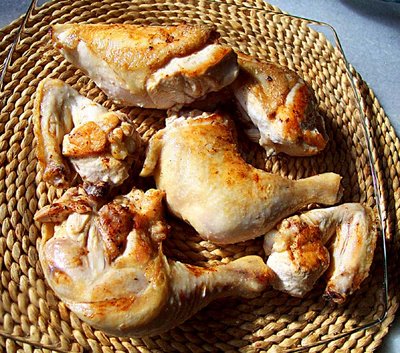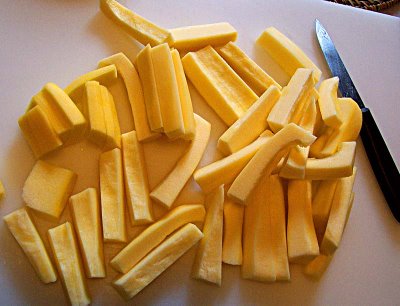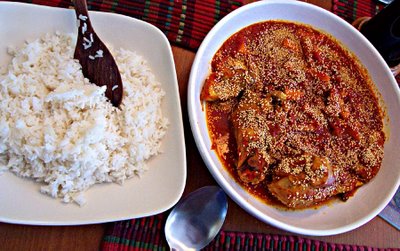The question then was what to do with them. Just bake them and have them with melted butter? Puree them and have them as a side dish? Make a pie?
As usual, the Internet provided the answer. The idea of making a sweet potato tajine [tah-ZHEEN] came to me, and I found a couple of recipes pretty fast. The first one was for a tajine of sweet potatoes and veal, and I had a package of cut up veal shoulder in the freezer, waiting for an opportunity.
Tajines are easy to make. The main thing you need is the North African spices — some combination of turmeric, cinnamon, cumin, ginger, nutmeg, cayenne pepper, and others. Curry powder would serve the purpose, with a little extra cinnamon and ginger added.
A tajine is meat and vegetables, or just vegetables, simmered in water and broth with all those spices until all the flavors mingle and the ingredients are well cooked and succulent. It's a Moroccan-style stew, often cooked in an earthenware dish. Usually there are raisins, almonds, or dried apricots in the sauce for added richness.
I used veal in the tajine I made yesterday, but it would be really good with chicken thighs, for example, or some other pieces of chicken or turkey. The advantage of veal is that it is boneless and cooks up very tender. Turkey or chicken breast might be dry. But boneless thighs would be really good.
Here's the recipe:
Tajine of sweet potatoes and vealWe made some roasted millet, which is cooked like rice, to go with our tajine yesterday, but it would be very good with couscous or even rice. Or just as it is — the potatoes are starchy, after all. It was good and filling, and I'm sure the leftovers will be even better today or tomorrow.
2 lbs. veal, cut into 1" pieces
2 large sweet potatoes
2 large onions, sliced
2 cloves garlic, chopped
½ cup raisins
6 dried apricots, cut into dice
2 Tbsp. fresh chopped coriander or basil
3 Tbsp. olive oil
2 bay leaves
1 tsp. ginger
1 tsp. turmeric
1 tsp. sweet paprika
pinches of cumin, cayenne pepper, and cinnamon
1 tsp. salt
½ tsp. black pepper
Peel and slice the onions and chop the garlic. Saute them along with the meat, the garlic, and all the spices spices in 2 Tbsp. olive oil in a big pot. Brown the meat and onions well, stirring to keep them from sticking. Then pour in enough water the just cover the meat. Put a lid on the pot and let it cook on low heat for 90 minutes, or until the meat is tender.
Meanwhile, peel the sweet potatoes and cut them into big chunks.
When the meat is close to done, add the sweet potatoes, raisins, and dried apricots to the stew and turn up the heat just a little. Let that simmer, covered, for 30 or 40 minutes longer, adding water as necessary to keep it all moist but not soupy. When the sweet potatoes are done, it's ready.


















